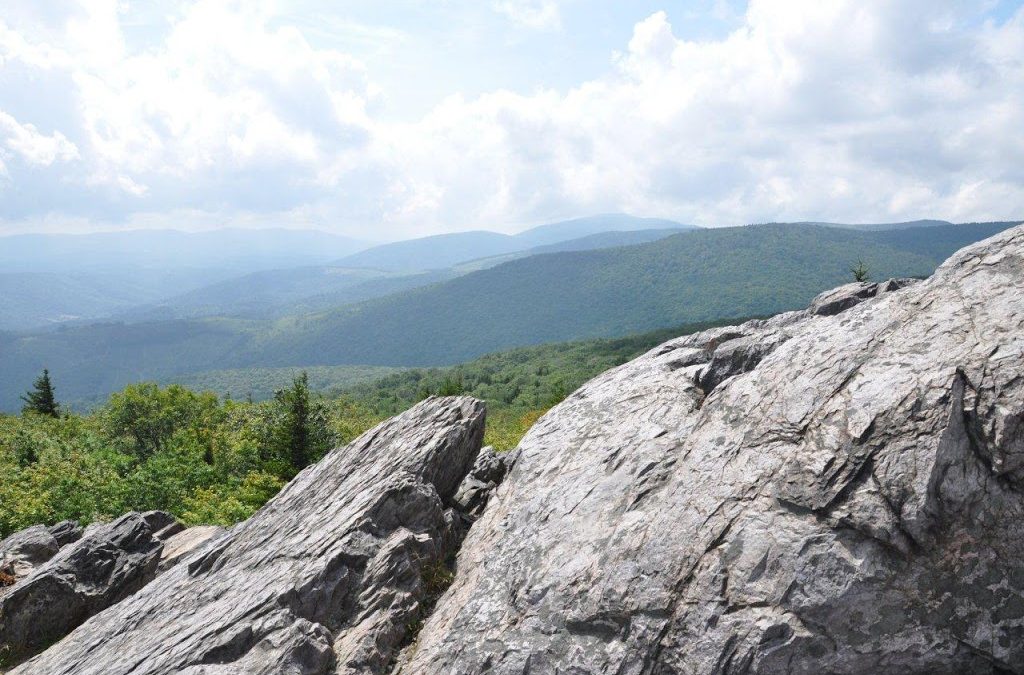
by admin | Aug 15, 2013 | Beyond the State, North Carolina
Scrambling to get in a vacation before the first day of Kindergarten, we escaped the summer heat and pointed our car north, spending two weeks frolicking in the cold streams of North Carolina’s Smoky Mountains and the air conditioned museums of Washington, DC. If I captured a day-by-day journal of our travels, I’m afraid this blog would turn into a book, so instead I’ll share some of the highlights and memorable adventures.
Our Cabin
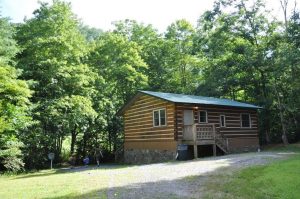 |
| Alarka Creek Cabin 2 |
When the listing on our Alarka Creek Cabin said Bryson City as the location, I pictured a small cabin on a creek just on the outskirts of the town’s main street. However, when the directions arrived via email, we found ourselves driving deep into the woods 15 minutes from the nearest cell phone and Internet connections. I must admit, at first it took a little adjusting. But after a day or so of being completely unplugged, we began to relish in our daily duties of exploring the creek running through our backyard, collecting fireflies in the nearby field and passing away the evening playing board games. The giant black snake eating his dinner off our back porch was an added bonus for the kids as was the family of frogs living underneath the garden water hose.
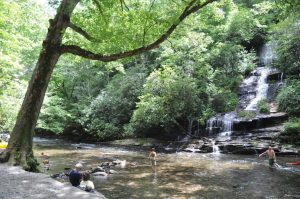 |
| Waterfall at Deep Creek in Great Smoky Mountain NP |
The Views
As we stood on the Blue Ridge Parkway gazing at the fog hovering between the blue-shaded rows of mountains before us, we remembered what draws us back year after year. Perhaps those who live in these parts are accustomed to the daily beauty of the Smoky Mountains, but to a family growing up on the Gulf Coast’s flat horizon, it’s a rare and awe-inspiring site. It’s a place that spurs the imagination, where a walk through an old homestead creates amazement at the hardiness of early settlers and quick moving fog prompts a five-year-old’s questions as to where the smoke machine is located. Throw in a few magical waterfalls at Deep Creek, hikes through Joyce Kilmer’s old growth forest and displays of mad kayaking skills at the Nantahala Outdoor Center, and you have the prime setting for a place where dreams are brought to life.
Salamanders
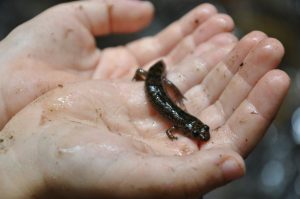 |
| One of the many salamanders we found |
After last year’s disappointment at not discovering a single salamander, a staffer at our favorite nature center in Highlands, NC, let us in on the secret. These shyest of creatures are found “under” the rocks, not on top. So low and behold, our five-year-old led us on daily excursions into icy cold streams to lift every accessible rock present. We were rewarded with countless salamanders, some black, some blue with spots and some so fast their color was a blur. Our best searching spots were at the end of the path leading out from Mingus Mill, in the pool at the base of Indian Creek Falls at Deep Creek, at the Highlands Botanical Garden and on the moist, loop trail behind the Peaks of Otter Visitor Center.
The City
 |
| Great Falls as seen from Maryland |
We don’t often take our kids to big cities, for obvious reasons starting with their tendency to wander off on a whim. Yet, after previously living in DC, we felt comfortable shuffling them around the metro to some of our favorite haunts. To ease them into the transition from wilderness to concrete, we started off at Great Falls, where the Potomac River drops 77 feet in less than a mile. The walk along the C&O Canal reminded us of our wish to bike the entire 184.5 miles and started the wheels spinning on how old the kids would need to be before we could embark on this trip.
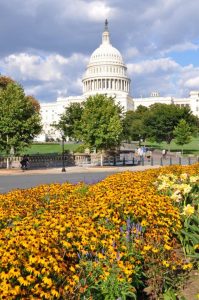 |
| U.S. Capitol |
Next, we were off to visit our old friend Abe, who despite recovering from a recent vandalism attempt, still sat as impressive as ever. On the opposite end, we walked the Capitol steps on our way to the Botanic Gardens, one of our all-time favorite places. Of course, there was the dinosaur exhibit at the Natural History Museum (twice!), the Carousel ride on the National Mall and a tour at my husband’s previous employment – The Phillips Collection (one of the best art museums NOT on the Mall).
Unexpected Finds
No matter how well you explore an area, there are always unexpected surprises that pop up in every trip. This time we ventured off the highway to Virginia’s Grayson Highlands State Park, where wild ponies run free and a hike through the forest leads to a rock outcrop with outstanding views of the state’s two highest mountains. On the road there, we nearly missed the state’s Marion Fish Hatchery and made a quick u-turn to stop by. It was our lucky day, as a bear had ripped the feeder off the wall the night before, so instead of buying a handful of fish food for a quarter, we were rewarded with a whole bucket of food to feed every fish in the hatchery. The kids squealed as the fish splashed and jumped at the food, and our oldest found a new best friend in the manager who gave us a personal tour of the facility.
 |
| Monticello’s Gardens |
Our other surprise was in Charlottesville, Va., where we stopped off for another look at Thomas Jefferson’s Monticello. Years ago when we visited here, you could drive straight to the house, park beside the bookstore/gift shop and snap a few photos without even buying a tour ticket. Today, the UNESCO World Heritage Site greets visitors with an expansive entrance, complete with a movie, children’s Discovery Room, cafe and gift shop. The home itself is hidden from view, accessed by a shuttle ride up the hill. Despite our surprise, we paid the $24/person fee and embarked on a journey through his home and extensive gardens. If you’ve never been, it’s still well worth the visit to learn about this fascinating president.
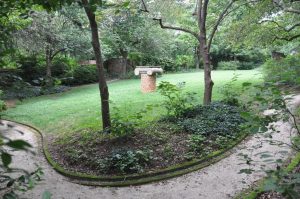 |
| Walled garden at the University of Virginia |
Below his mountain, on the campus of the University of Virginia, we picnicked on the main lawn and then set off to investigate the walled gardens of the Academical Village. It was a private, magical place, where individual gates led from one small manicured garden to the next. Here, in the middle of campus, tiny bunnies raced across the grass to hide in thick bushes, and we found ourselves not able to stop exploring until we had found each and every garden.
A Few Parting Photos
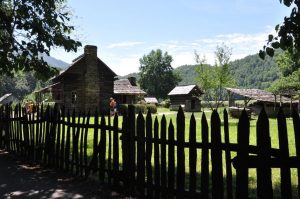 |
| Mountain Farm Museum at Oconaluftee Visitor Center at Smoky Mountains NP |
|
|
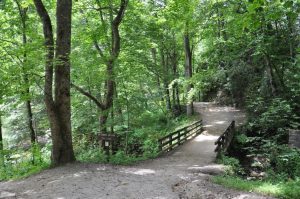 |
| One of our scenic hiking trails |
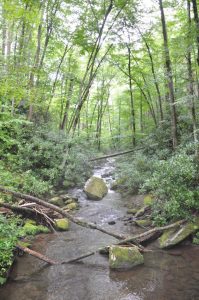 |
| And one of the beautiful creeks in the Smokies |
|
|
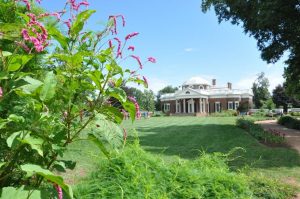 |
| Thomas Jefferson’s Monticello |
 |
| Can you spot the salamander? |
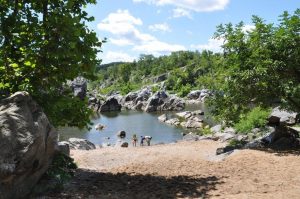 |
| A tranquil pool at Great Falls |
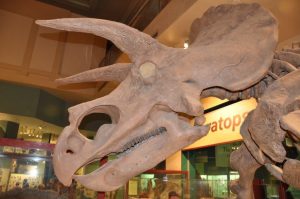 |
| Dinosaurs at the Natural History Museum |
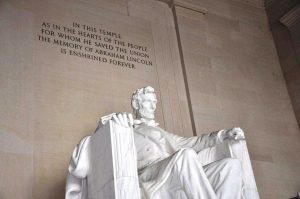 |
| Abraham Lincoln Memorial |
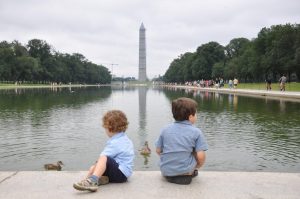 |
| Feeding ducks by the reflecting pool and Washington Monument |
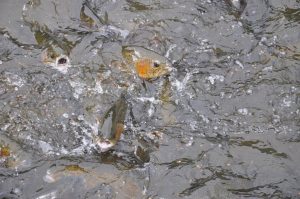 |
| Feeding the fish at the Fish Hatchery |
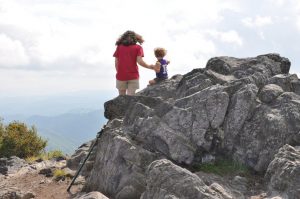 |
| Enjoying the view at Grayson Highlands |

by admin | Jun 30, 2013 | River Road
There is no shortage of scenic roads in this state, including many portions of Louisiana Highway 1. The longest road in the state, it runs from Grand Isle to north of Shreveport. We tackled a small portion of it last weekend, driving from Donaldsonville to Port Allen up the westbank of the Mississippi River before crossing over to end at Baton Rouge.
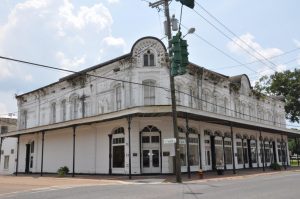 |
| Former Department Store, B. Lemann & Bro. building, in Donaldsonville |
Just a short distance from the Sunshine Bridge, Donaldsonville stands as the parish seat of Ascension Parish and a former capitol of the state of Louisiana (back in 1830). The town’s population and importance in history have fluctuated over the years, as evidenced by the vine-covered ruins of homes just off the main roads of Louisiana’s second largest historic district. Yet, the downtown streets are lined with impressive buildings that testify to this town’s importance and prosperity in the 1800s, long before the industrial plants entered the scene of this agricultural economy.
Many of the buildings are maintained today, such as the red brick courthouse and the one-time department store B. Lemann & Bro. building, both designed by architect James Freret. My particular favorites were the elk-adorned Italianate Elks Lodge and the “For Sale” Bel House, which looked like it was plucked right out of New Orleans’ French Quarter. Donaldsonville also lays claim to primitive artist Alvin Batiste.
 |
| Nottoway Plantation |
From here, we continued north toward Iberville Parish and the town of White Castle, famous for the south’s largest plantation resort – Nottoway Plantation. With 64 rooms and 53,000 square feet within the walls of this massive palace, Nottoway is best seen from River Road, where its white-columned front faces the Mississippi River. Built in 1859, this plantation was a modern marvel for its day, boasting running water in the bathrooms and gas lighting throughout the home’s interior. Today, the plantation has indeed become a resort, with a Grand Pavilion, a Mansion Restaurant, outdoor pool and cabana, and tennis courts. On the day we visited, tents were pitched throughout the property and RV’s lined the outer edges of the parking lot. We hadn’t passed a soul on River Road, yet Nottoway was swarming with people – certainly a hot attraction for the area.
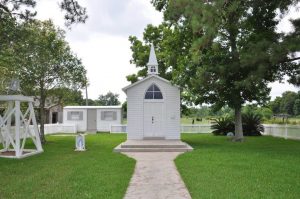 |
| Madonna Chapel |
In sharp contrast to Nottoway, the world’s smallest church resides just up the road in Bayou Goula. The tiny, one-room Madonna Chapel is sandwiched between a new house and a field of grazing cattle. We initially passed the site and, after turning around, pulled off the edge of River Road to make our own parking space. The kids bolted in the white picket fence in search of the hidden key to unlock the chapel. It wasn’t really “hidden,” only tucked away inside a box labeled “key,” but seeing as neither of them can read yet, they had quite the scavenger hunt.
The chapel was stifling hot inside, and we left the door open wide as we gazed at the small altar covered in statues of Jesus and Mary and read its touching story. Only eight feet square, the chapel was built in 1903 by a farmer, Anthony Gullo, who promised to build a church to the Madonna if she helped his oldest son recover from a serious illness. An annual mass is held here on August 15 in celebration of the Assumption of the Blessed Mother.
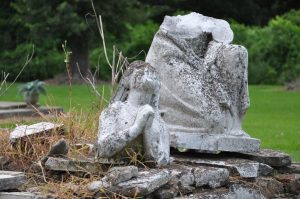 |
| St. Raphael Cemetery |
Our next stop was St. Raphael Cemetery, a crumbling grouping of graves and monuments laid out in the bend of the river across the Mississippi from St. Gabriel. Aside from the interesting architecture of the tombs, this is also the final resting spot for Louisiana’s 15th governor, Paul Octave Hebert.
River Road reconnected with Highway 1 in Plaquemine. A summer thunderstorm was rolling in as we pulled up to the Plaquemine Lock State Historic Site, and the skies opened up the moment we entered the lockhouse. The friendly, knowledgeable state park guide welcomed us to the museum and seemed to cater to our every need. Our two-year-old, August, was mesmerized by the working scale model of the lock system, anxiously watching the tiny lock doors open and the boat slowly make its way inside the lock. My husband grabbed a complimentary coffee and headed up the winding staircase for pristine views of the Mississippi River.
 |
| Plaquemine Lock State Historic Site |
As the rain stormed on, the ranger started a funny movie about singing fish to entertain the kids so we were free to browse the exhibits. We discovered the lock was built between 1895 and 1909 to connect the river with Bayou Plaquemine and was designed by Col. Goethals, who later became chief engineer of the Panama Canal. It operated for 52 years until shutting down when a larger lock was built in Port Allen.
When we ventured outside again to view the structure itself, my five-year-old, Charles, spotted an oversized beetle hiding in the doorjamb. Our host then pointed out an even larger beetle (scarily large) that thrilled Charles for the rest of the weekend. He made the bug a home in a coffee cup and carried him all over the property, from our walk up the levee to our stroll across the lock bridge and far below to the lovely waterfront boardwalk. After we (and the bugs) finished our journey, we drove the streets of Plaquemine, gazing at the historic homes and the St. John the Evangelist Catholic Church, “The Cathedral on the Bayou.”
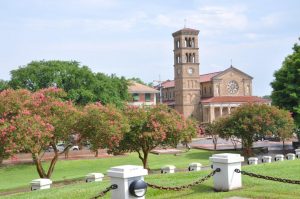 |
| St. John the Evangelist in Plaquemine |
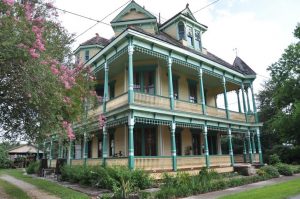 |
| Historic Home in Plaquemine |

by admin | Jun 18, 2013 | Featured Posts, Greater New Orleans
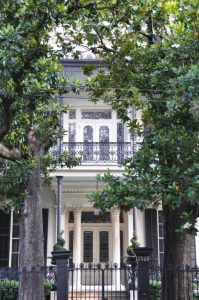 |
| Another Garden District Beauty |
In the midst of t-ball and swim lessons, we’ve been sticking close to home as of late, taking short adventures in and around New Orleans. Our latest outing was something we rarely do, a guided walking tour of one of the most extravagant sections of the city – the Garden District. Once home to wealthy Americans looking to settle outside of the French Quarter, today many of the area’s mansions boast historic signs detailing fascinating stories that often end with links to Hollywood stars.
We met our guide, Kevin from NOLA Native Tours, on Magazine Street at the Defend New Orleans store. The early morning weather was clear with a cool breeze that made the shaded sidewalks comfortable on this mid-summer day. Kevin led us north on 1st Street, deep into the heart of the quiet neighborhood. Aside from the occasional dog-walker, we had the street to ourselves, with no one watching us gawk at the beautiful homes before us.
In the early 1800s, this area was known as the city of Lafayette, eventually annexed by the city of New Orleans in 1852. Our tour guide pointed out notable architecture styles, from Victorian to Italianate and Greek Revival, all with varying degrees of cast iron railings and flickering Bevelo gas lanterns. I was particularly fascinated by the large marble slab lying by the curb in front of one of the homes. I never would have guessed it was once used as a step for ladies exiting carriages, a fact that so easily painted an imaginary scene of well-dressed revelers arriving in their carriage for an evening party.
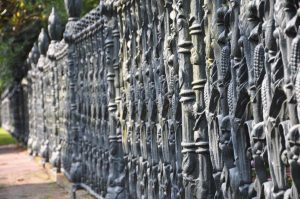 |
| Cornstalk Fence |
We passed the home where Jefferson Davis, the first and only president of the Confederacy, died. Nearby, vampire-author Anne Rice grew up in the Brevard-Rice house, just a few steps away from the Mannings’ mansion (yes, that would be the Mannings…football icons Archie, Peyton and Eli). On Prytania, the French flag waved in front of the French Consulate, while across the street, a rectory once built for Redemptorist priests later became another possession of Anne Rice and then actor Nicholas Cage. Meanwhile, an intricate cornstalk fence surrounded one grand home, proving that the famous fence does exist outside of the French Quarter.
The tour paused at the Rink, a collection of boutique stores, the Garden District Book Shop and a coffee shop, before unleashing us inside Lafayette Cemetery Number 1. We spent nearly half an hour here, photographing the elaborate above-ground tombs with springy plants emerging from their crevices. This city of dead is crowded and slightly crumbling, details that somehow make it even more alluring.
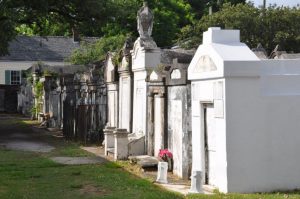 |
| Lafayette Cemetery |
The last stretch of our journey showcased one of the city’s best-known restaurants – Commander’s Palace, and exquisite homes perhaps more famous for their architecture than for their Hollywood owners (Sandra Bullock and John Goodman). It was a pleasant walk in the hands of a knowledgeable tour guide, one who casually turned a morning stroll into an exploration of beauty, time and entertainment.
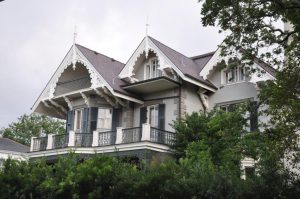 |
| Sandra Bullock’s Garden District Home |

by admin | Jun 4, 2013 | Greater New Orleans
On a coveted three day holiday weekend, t-ball and birthday parties kept us tied to the city, so we used the extra day to explore our hometown. It’s so easy to settle into work and school routines during the week, and take off exploring the unique small towns and parishes on our days off. Yet, I also find that we often forget how interesting our own city of New Orleans is, so we donned our tourist hats and headed to the French Quarter.
Being a local has a few perks, such as knowing to park at the foot of Canal Street at the Shops at Canal Place. We spent five minutes buying the kids a muffin at Starbucks, and then immediately took our parking ticket to the Concierge to be validated (a nice savings in parking fees). Another perk was catching half-price tickets to the paddlewheeler Creole Queen on Travelzoo – all the motivation we needed to try out the river cruise.
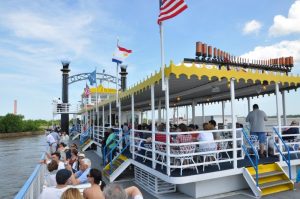 |
| Aboard the Creole Queen |
We walked the short distance to the boat’s dock and secured our tickets for the daily excursion. The line to board was already wrapped around the side of the Riverwalk, and with one glance at the kids, we knew they were not going to wait. So we instead strolled along the river, watching the massive ships go to and from the busiest port complex in the world. We returned as the last of the passengers took their group photo and passed through security. The downside of waiting to the end was no more available seats on the ship’s deck, but seeing as our two- and five-year-old rarely sit for long, it wasn’t that big of a deal.
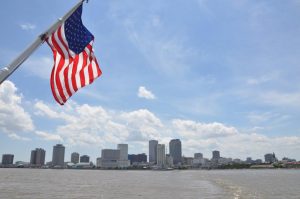 |
| View of the city from the Creole Queen |
We watched as they unwound the ropes holding the boat to the dock and started up the paddlewheel, slowly propelling us out into the middle of the river. Inside people were lining up for hot food and cold drinks, while we toured the boat, investigating the view from every floor and side. A narrator pointed out memorable locations, and the kids discovered hiding places under overhanging decks and built-in “slides” next to indoor stairways. We relished in the breeze counteracting the hot sun, and hid in the shadows when we needed a break. Before long, we passed the Bywater, the Industrial Canal and the Louisiana National Guard’s headquarters at Jackson Barracks on our way south to Chalmette Battlefield in St. Bernard Parish.
As many times as we’ve walked the grounds and toured the home at this National Historical Park, we
 |
| Musket firing demonstrations at Chalmette Battlefield |
had never arrived via the river and never visited on a day when costumed living historians had set up camp on the property. We learned how young ladies looked “graceful” while playing games, explored a tent and common items carried by 1815 soldiers and watched musket firing demonstrations that had our youngest shouting “No!” at the volunteers. Meanwhile, our oldest, Charles, was anxiously listening for the one long and two short whistles that would signal our five minutes to reboard. As soon as they blew, he took off running toward the boat, warning us he would leave us behind if we didn’t make it back in time.
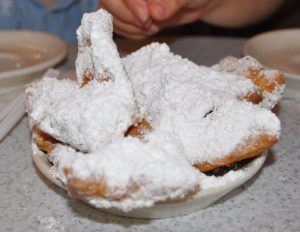 |
| Cafe du Monde beignets |
The kids were tired when we finally arrived back at port, so we popped them in the strollers and let them relax as we walked along the river down into the heart of the Quarter to Cafe du Monde. Once again, the line for outdoor seating was stretched far out beyond the famous cafe, but we strolled right past them and entered the air conditioned indoor area and grabbed one of several empty tables. Here, we re-energized with cafe au lait, and the kids perked up with a great deal of powdered sugar on top of their beignets. You could sense the sugar settling into their system, sending jolts of energy through every inch of their tiny bodies.
 |
| Andrew Jackson in Jackson Square |
Rearing to go, we crossed the street to Jackson Square, greeting the mules lined up waiting to lead
buggy tours. While August “neighed” at them, Charles spotted a balloon man and scored them both balloon swords, which came in quite handy for the sword fight that ensued around the statue of Andrew Jackson. The Quarter was alive with music and street performers, brass bands and cheering crowds. A wedding party paused to snap photos outside St. Louis Cathedral before the bride took a deep breath and entered the church doors. We took it all in for a while, venturing around back of the Cathedral to investigate the artists there and savoring the vibrancy for which New Orleans is known.
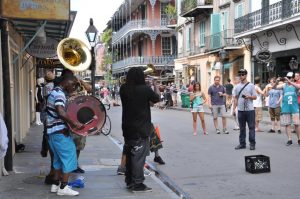 |
| Musicians on Royal Street |
When the musicians paused, we took our cue and headed up Chartres to the Napoleon House for a dinner of shrimp remoulade and red beans and rice for the kids. Paul and I topped it off with a Pimms Cup, a light, summer drink, and reminisced about our own wedding reception held upstairs here more than 10 years ago. Built in 1797, the house was offered in 1821 as an escape to exiled Napoleon. Although the French leader never made it to Louisiana, the restaurant and bar today pay homage to him through paintings, statues and various decorations all depicting Napoleon and his life.
 |
| Napoleon House |

by admin | May 15, 2013 | Cajun Country, Most popular
On one of the last cool weekends before summer, we jumped in the car to visit Avery Island, home to Tabasco as well as the beautiful oasis, Jungle Gardens. On previous trips, we always took I-10 from New Orleans to Breaux Bridge and then headed south. This time, however, we made our way along the southern route, traveling Highway 90 through Morgan City, Patterson and Franklin before reaching our destination.
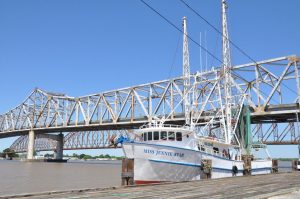 |
| Atchafalaya River as seen from Morgan City |
The drive brought us through scenic vistas of classic Louisiana swamps. While the kids watched “Ice Age” in the back of the car, we immersed ourselves in the abundant cypress trees basking in the dark waters prolific in this part of the state. Our first destination was Morgan City, sporting a slogan “Right in the Middle of Everywhere” and famous for its annual Shrimp and Petroleum Festival (the name says it all). On a map, Morgan City makes up half of an island surrounded by countless lakes, rivers, bayous and various other bodies of water twisting and turning around the floating land.
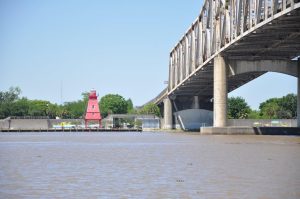 |
| Southwest Reef Lighthouse |
We headed straight for the historic downtown toward Front Street and the towering floodwall protecting the city from the Atchafalaya River. The road led us to an opening in the floodwall, and we parked at the edge of the river beside a handful of people fishing. The kids were elated to finally stretch their legs and set off at a sprint along the dock. We raced behind, taking in the muddy river and the boats tied up at its side. Before long, we ascended the stairs to the floodwall and looked down at the city below. Traffic was light on this Saturday morning, yet shops appeared to be opening in the historic buildings.
The floodwall gave us a great view of the river, and the three bridges spanning across it–one for trains and the other two for cars. One of them, the Long-Allen Bridge, boasted a pier resting on one of the deepest foundations in the world (176 feet below low water stage) when it was built in 1933. Across the river, a bright red lighthouse stared back at us. Known as Southwest Reef, the lighthouse was built in 1858 and relocated in 1987 from the Atchafalaya Bay to a park in Berwick.
 |
| Wedell-Williams Aviation and Cypress Sawmill Museum |
After our walk, we drove the streets admiring the buildings, churches and parks. It was a brief stay, though, as we had several other destinations for the day including the Louisiana State Museum in Patterson. The Wedell-Williams Aviation and Cypress Sawmill Museum showcases two very different occupations that were both integral to this small town.
On one side of the museum, brightly colored airplanes are scattered about both the floor and ceiling. In 1928, pilot Jimmie Wedell and oilman and timber baron Harry Williams joined forces to design aircrafts in Patterson that were faster than the competition. At the announcement of the movie, we all grabbed a seat and waited for the multiple screens to lower across the room. The kids were wide-eyed as planes raced from screen to screen and simulated wind blew in our faces. Wedell and Williams were daredevils of their time who used their fearless talents to revolutionize the aviation industry.
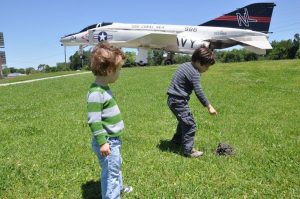 |
| The fascinating crawfish home in front of the museum |
Across the lobby, the cypress sawmill museum tells the industry’s story through pictures, giant logs and, if possible, even larger saws. Louisiana played a critical role in the country’s logging industry, and at one time, Patterson was home to the largest sawmill in the world. It was both amazing and eye-opening, and exactly the right size for the attention spans of our kiddos. We had just wrapped up our tour when they scooted out the front door to investigate the crawfish homes on the front lawn, oblivious to the jet mounted just above their heads.
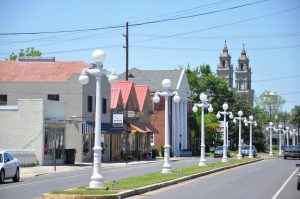 |
| Franklin’s Historic District |
Down the road in Franklin, we took a whirlwind tour of the downtown, which boasts over 400 historic structures. I have to say I have never seen so many historic signs all standing in one place. We immensely enjoyed the scenic main street, filled with shops and picturesque light poles. Spanning out on either side were pristine white mansions, shrouded in a canopy of moss-covered live oaks. One block away, the much-talked-about Bayou Teche flows past the homes, adding to the laid back, Southern feel already emanating from the town.
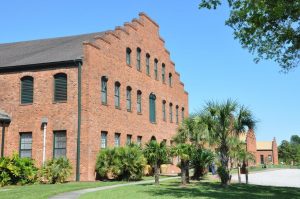 |
| Tabasco Factory at Avery Island |
It was nearly 3 o’clock by the time we arrived at Avery Island, paying our dollar toll to cross the bridge to enter Tabasco territory. Home to the McIlhenny hot sauce empire, Avery Island sits on one of five salt domes found in this part of Louisiana. They say that the salt here is “as deep as Mount Everest is tall,” a mind boggling thought. The factory was closed the day we visited, but we were still able to tour the facility that strongly smelled of the spicy sauce. The kids were thrilled when the tour guide gave them samples of miniature Tabasco bottles, which have now taken a spot of fame in their own collections at home.
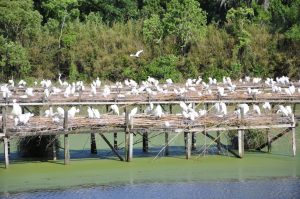 |
| Snowy Egrets at Jungle Gardens |
Aside from Tabasco, Avery Island is home to the wild and beautiful Jungle Gardens. A driving tour through the 170-acre gardens brought us past alligator-filled ponds, an 800-year-old Buddha and countless live oaks, azaleas, camellias and bamboo. Thankfully, the unseasonably cool weather kept the mosquitoes at bay so we could enjoy exploring every inch of the property. It was also the perfect time of year for the nesting snowy egrets, which came in droves to the elevated platforms known as “Bird City.”
 |
| Bayou Teche National Wildlife Refuge |
All in all, it was probably one of our most successful adventures already, but we added one final stop to complete the tour. On the return drive, we veered off south of Centerville to enter the Bayou Teche National Wildlife Refuge, established in part to protect Louisiana’s black bear population. While we weren’t looking for bears, we were intrigued by the Garden City boardwalk trail, which we never would have found without this map. We parked by the levee and walked the short distance to an even shorter boardwalk through the swamp. The water underneath was eerily still, clogged with vegetation in this thriving forest; yet the trees overhead were alive with songbirds, each twilling a different tune and flitting about from branch to branch in a blur of colors. We paused a moment to admire them all before climbing back in the car for the return trip home.
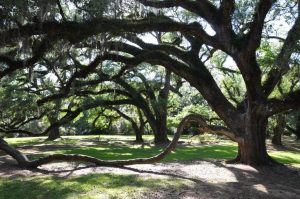 |
| Live oaks at Avery Island’s Jungle Gardens |


















































